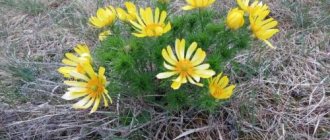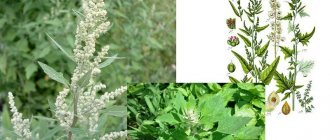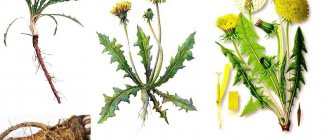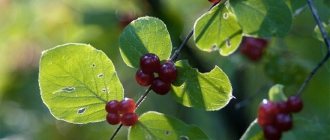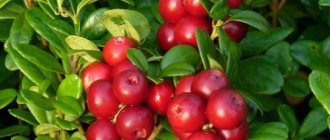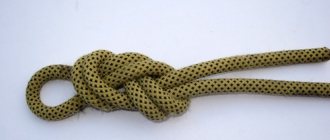Siberian cedar pine
An evergreen tree typical of dark coniferous taiga. It grows up to 44 m, the trunk diameter reaches 2 m. Life expectancy can exceed 500 years. The tree has a straight, even trunk, a dense crown, soft, bluish needles and large, ovoid cones filled with seeds - pine “nuts”. There can be up to 150 of them in each cone. In one season, a tree can produce about 12 kg of “nuts”.
Hazel
Deciduous shrub of the Birch family. It is found in coniferous, mixed and deciduous forests as undergrowth, and quickly grows in areas of forest clearings and fires. In optimal conditions it lives up to 100 years. It reaches a height of 5 m, has an ovoid or spherical crown. The leaves are large, up to 12 cm long, up to 9 cm wide. The fruits ripen in August-September and are nuts with a dense shell. The kernels are used in the food industry for the preparation of halva, sweets and other products.
Understory plants
What plants grow in the forest? Large canopy trees provide shade to the undergrowth, so shade-loving vegetation prefers to be located there. In such places, evaporation and temperature of the surface layer of the earth are significantly lower. These conditions are favorable for fungal growth. It seems strange, but the rowan tree that grows in the forest is a relative of the magnificent rose, which is extolled for its most magnificent flowers. And rowan is popular for its clusters of bright red berries, bark and leaves that have healing properties. In Rus', it has long been believed that the rowan spirit helps to ward off diseases. It occupies significant areas of undergrowth.
Honeysuckle, a shrub that grows in the forest, blooms for a whole month, attracting insects with its fragrance. It is part of the undergrowth. Plants with edible berries are represented in the Far East and eastern Siberia. The taste of the berries is reminiscent of blueberries. Euonymus is a typical undergrowth shrub; it has poisonous but very beautiful fruits that are used in medicine. In garden plots it is used as an ornamental plant. Not all small trees represent undergrowth. It does not include young canopy trees called juveniles.
Euonymus warty
Deciduous shrub growing in coniferous-deciduous and broad-leaved forests. His average life expectancy is 50 years. It grows up to 2-3.5 m, and is also found in the form of a tree up to 6 m high. The branches of the bush are thin, covered with numerous growths. The leaves are simple, smooth, green in spring and summer, pink or reddish in autumn. The flowers are small and emit a “mouse” smell. Ripe fruits have an attractive bright color, but eating them risks poisoning, since the plant is poisonous.
What plants grow in the forest?
On the territory of Russia there are such forests as coniferous, mixed and broad-leaved. These forests are rich in a variety of beautiful vegetation. Various species of shrubs, trees and grasses are represented in Russian forests.
Vegetation of broad-leaved and mixed forests Closer to the south of the taiga, broad-leaved and mixed forests originate, which consist of different trees. Aspen, birch and linden trees grow in these places. In this part of Russia, the climate is milder than in the north, so deciduous trees develop in full force, they mix and form mixed forests. In fact, in the forest zone, apart from pine trees, there are no coniferous trees. Their places were taken by broad-leaved species.
Trees that grow in broadleaf forests vary in height and grow in tiers. The tallest include oak and ash, slightly lower - linden, elm, maple, and even lower are field maple, wild apple and pear trees. Shrubs grow under the trees, these include buckthorn, raspberry, hazel, viburnum and others. The grass cover is very well developed here. In such places many types of medicinal herbs grow, and you can also find plants that are listed in the Red Book.
Moss in mixed forests can only be seen in damp and dark places. The fertility of these forests is evident in the wide variety of mushrooms and berries. In mixed forests, many light-loving berry plants grow, namely strawberries, blueberries, raspberries and drupes.
Vegetation of coniferous forests Coniferous trees, or as they are also called evergreens, grow throughout most of Europe and Russia. These trees are called conifers because instead of leaves they grow needles, that is, small green needles that perform the same function as leaves, namely, they absorb carbon dioxide and release oxygen. Let us note the fact that coniferous forests produce a lot of oxygen, thereby ensuring the life of the entire planet.
The most common coniferous trees are spruce, pine, fir, larch and cedar. They grow in large tracts, in forests and taiga. Such tree species live separately. There are pine forests where only pine trees grow, and there are parts of the forest where only spruce trees grow, and they are called spruce forests. And now we will find out what other plants grow in the forest, besides trees.
In coniferous forests you can find yellow acacia, red elderberry, strawberries, nettles, celandine, and bracken. Among the flowers, we can highlight the snowdrops shepherd's purse. Herbs that grow in coniferous forests can adapt to not very sunny summers and cold winters.
But to be honest, there are not many herbaceous plants growing in coniferous forests, and this is because in such forests there is very little sunlight, as it is absorbed by the high canopy of trees. Therefore, only the most resilient survive in this place. And herbaceous plants such as lichens and mosses feel especially good in this place.
Now you know what plants grow in mixed and coniferous forests.
Black elderberry
Deciduous shrub growing as undergrowth in deciduous and coniferous forests. It is also found along roads, in vacant lots and in populated areas. It reaches a height of 6 m, in rare cases it grows up to 10 m. Its stems have a porous soft core, the branches are covered with numerous lentils. The leaves are complex, large, up to 30 cm long. The flowers are yellowish-white, collected in multi-flowered corymbose inflorescences, and emit a strong aroma. The fruits are berry-shaped, black and purple. The plant is moderately poisonous to mammals.
Ozsika
Ozhika (Luzula) are perennials of the rush family (Juncaceae), more or less evergreen, preserved under snow.
The leaves are clustered mainly at the base of the stem, arranged spirally and form a funnel when viewed from above. They are relatively wide, grooved, with a flat, smooth surface; the veins do not stand out. Along the edge there are sparse long and soft hairs. The inflorescence is apical, in the form of a loose panicle. The flower is bisexual and symmetrical with 6 brownish or greenish hard leaves, 6 stamens and a style with 3 stigmas. The fruit is a capsule surrounded by perianth.
O. pale (L. pallescens, or L. pallida). The rhizome is shortened, the curtains are dense.
The leaves are protruding, light green, up to 4 mm wide, with sparse hairs along the edges. Stems up to 40 cm tall. Inflorescences are oblong spikelets. The boxes are round, light brown.
Top articles: How to care for a German ShepherdBeautiful European view - o. Ozhikovidna, or oak forest (L. luzuloides or L. nemorosa), distinguished by brownish flowers, can be found in our old parks, where it naturalized. A common plant of damp meadows, light forests and roadsides of extratropical Eurasia.
A neat, unpretentious plant.
O. hairy (L.pilosa). Forms loose turf.
Leaves are up to 1 cm wide, spreading, shiny, with long hairs at the base. Stems up to 35 cm tall. The inflorescences are openwork, its branches are spread out, even bent down towards the end of flowering, few branches, with single flowers.
A common plant in the middle zone, more often found in forests with sparse grass in Europe, Siberia, and the Caucasus.
An unpretentious plant, suitable for shady flower beds with small plants, rock gardens.
O. forest (L. sylvatica). A large evergreen plant that forms lush rosettes connected by rhizomes.
The leaves are shiny, grooved, curved, more than 1 cm wide, with hairy edges. The stems are thin, up to 60 cm tall. The inflorescences are paniculate, loose, with light brown small flowers, collected in several pieces on thread-like branches.
Found in the forests of Western Europe and the Caucasus. Winter-hardy.
One of the most decorative flowers, suitable for shady flower beds, borders and rockeries.
Varieties:
"Aurea" ("Hohe Tatra", "Tatra Gold") - with apple-green young leaves that turn yellow in winter.
"Auslese" - up to 30 cm tall, leaves are light, tightly curled.
"Marginata" - the edge of the leaf with a narrow creamy-white border.
"Variegata" is a rare variety with a yellow border on the leaves and yellow flowers).
O. multiflora (L. multiflora). The turf is dense, up to 40 cm tall.
The leaves are protruding, up to 6 mm wide, densely hairy. The inflorescence is relatively dense, with branches sticking up. The flowers are dark brown, collected 8-16 in cylindrical groups. Distributed throughout the Northern Hemisphere, very variable, most likely representing a complex of species. A closely related species, distributed mainly in Europe, is o. plain (L. campestris), distinguished by noticeable rhizomes and rounded groups of flowers on splayed branches.
O. snowy (L. nivea). The plant is loose-turfy, with numerous narrow, up to 4 mm, leaves covered with long white hairs.
Peduncles up to 60 cm tall, with drooping lush inflorescences. The flowers are pure white, collected in groups.
Found in mountain forests of Europe. Winter-hardy.
A very beautiful, delicate plant for shady flower beds, especially in masses.
Kukushkin flax
A perennial leafy green moss that grows in places with high humidity. Its stems reach a height of 15 cm, in rare cases they can exceed 40 cm or more, have a brownish tint, and are covered along the entire length with small dark green leaves. The female plants develop pods that resemble a cuckoo on a pole. Moss is used as inter-crown insulation.
Male shieldweed
A forest fern with a short and thick rhizome, at the top of which there is a rosette of large leaves. Its lanceolate fronds can reach a length of one and a half meters, leaf petioles are covered with brown scales. On the underside of the leaf blade there are sori located in 2 rows. The fern spores until the end of August; the average age of the plant exceeds 30 years.
Wild strawberry
Herbaceous perennial, common among shrubs, in cleared areas and in cleared forests. Grows up to 30 cm, has a creeping rhizome. The leaves are serrated, trifoliate, white flowers are located in few-flowered inflorescences. The fruits are multi-nuts with a pleasant taste and aroma. Used for human consumption.
Cowberry
An evergreen shrub that grows in coniferous, deciduous and mixed forests, in thickets of bushes and other places. The usual height of the plant is 15 cm, but some bushes reach 1 m. At the end of spring, lingonberries bloom with regular white or pinkish flowers, collected in drooping clusters. The leaves are leathery, overwintering, and arranged alternately. The bright red berry-shaped fruits ripen in late summer - early autumn and have a sweet and sour taste.
Flowers in different seasons
Many may wonder what flowers grow in the forest in the spring, when there is still snow almost everywhere. The main and most famous ones include:
- snowdrop;
- violet;
- sleep-grass;
- lungwort.
Along with them, you can also find quite rare flowers that begin to bloom during the snowmelt period. A visitor to the forest can be pleased with flowers such as:
- Liverwort belongs to the Ranunculaceae family and is a small herbaceous perennial. The characteristic color is from white to purple, the flowering period falls in the second month of spring.
- Chistyak is also a perennial, which is endowed with varnished green leaves, looking like a small neat bouquet. The important fact is that during the ripening period these plants in the forest are considered the most poisonous of all.
- Corydalis is a herbaceous plant with light purple flowers. Most often you can find this representative in mixed forests from April to June.
In the sunny, hot summer, the forest attracts even more with its unique aromas, colors, and variety of flowers. After all, during this period you can easily find moonflowers, wild poppies, forget-me-nots, and blue cyanosis.
But do not forget that there are also those flowers that begin to bloom at a later period - in autumn. Of course, as a rule, they are not so colorful. But they still surprise and fascinate with their beauty. The main plants of this period include:
- anemone;
- gentian;
- clover;
- Kulbaba;
- violets.
Non-flowering plants
It often happens that when walking through the forest, your gaze may involuntarily stop at a plant that, although it does not have flowers, looks incredibly attractive. These include the following plants that grow in the forest in almost any climate:
- Kochedyzhnik - belongs to the genus of ferns, has short leaves that are covered with brown scales. Since it reproduces very quickly, it can form thickets.
- Horsetail is a perennial herbaceous plant with a rather interesting texture. It has hard, branched green spikelets.
- Cuff is a creeping perennial plant with unremarkable flowers that are collected in umbels.
Edible berries
In addition to the desire to retire and admire nature, people also go to the forest to pick mushrooms or berries. As for the latter, it is most likely to collect them in summer or autumn.
often find berries such as lingonberries, stoneberries, blueberries, blueberries . All of them are very tasty and are consumed by humans in different forms. Therefore, their search is carried out with great pleasure.
Cranberries are also forest dwellers, growing in marshy areas, characterized by a sour taste and bright red color.
Of all the berries listed, this one is considered the most useful and healing. It should be noted that even when preserved it does not lose its properties.
The difference between poisonous berries
Any forest visitor simply must know how to distinguish edible berries from poisonous ones. Especially if he plans to enjoy them. The first sign that the berry can be eaten is the presence of bird droppings on the bushes or ground near the plant, as well as seeds or peels from it. Although, of course, such an observation does not provide a guarantee.
In almost all forests grow such poisonous berries as wolf's bast (small spherical fruits of bright red color, consumption even in small quantities can be deadly), crow's eye (shiny berries of a searing blue color), speckled hemlock (egg-shaped fruits, very look like cherries).
Ivan-tea angustifolia
A herbaceous perennial common in coniferous forests. Often found on the outskirts of forests, in clearings and burnt areas, near ditches and along railway embankments. It grows up to 2 m. It has a densely leafy, straight stem, alternate, simple, linear-lanceolate leaves and pinkish flowers collected in a sparse apical raceme. Flowering begins in mid-summer and lasts about 35 days. The fruits in the form of fluffy boxes ripen in August-September.
Southern tree varieties
Southern trees are characterized by good resistance to drought and heavy rainfall. These plants grow in regions with hot climates. The list of trees includes poplar, apricot tree, cypress, sumac. They grow in plant nurseries or in summer cottages and suburban areas.
Cypress
Cypress is a type of evergreen, fast-growing species. Cypress is a perennial tree that grows up to 25 m. The plant can take the form of a bush up to 2 m long. The main growth of cypress occurs in the first years of its life. Then it increases by several centimeters every year. The lifespan of cypress is up to 2000 years. Its trunk can be straight or slightly curved, the bark is smooth, and over time acquires a furrowed structure. The leaves of the plant are scaly.
Important! Cypress is difficult to care for, so it needs to be periodically fertilized and given preventative vaccinations.
Acacia
White acacia is a plant that belongs to the Legume genus and grows in the south. Acacia can be shrubby or woody. The height of the tree is up to 30 m, the width of the trunk is up to 2 m. Acacia has a wide crown that spreads over several meters. The leaves of the tree are long, up to 25 cm, imparipinnate. The fruits of the plant are beans, up to 6 cm long. Each of them contains about 8 seeds. Their ripening begins in mid-late September.
Poplar pyramidal
Pyramid poplar belongs to the Willow family. Its length varies within 40 m, and the width of the trunk reaches 1 m. Poplar has a pyramidal crown, its flowering begins in late April and early March. Average life expectancy is 300 years. Poplar has smooth gray bark and a well-developed root system. Because of this, poplar growth occurs quite quickly. The leaves of the plant are distinguished by a diamond-shaped shape, and its flowers are combined into long catkins.
Ash
Ash is a deciduous tree. Its height can reach 40 m. The shape of the crown is rounded, the branches of the tree are directed upward.
Lone ash tree with a spherical crown
The trunk has a cylindrical shape. Ash leaves form an inflorescence of 10-15 small green leaves. The fruits of the plant, lionfish, grow up to 5 cm. At first they have a green tint, then turn brown. Flowering begins in spring, after a long winter sleep.
Best articles: Can you feed your dog cheese?
Important! Ash is unpretentious to growing conditions, so it can exist even in swampy areas
Sumac
Staghorn sumac has another name - vinegar tree. This is a plant that belongs to the Sumakhov subspecies. For the first time, the plant, according to the tree encyclopedia, appeared in North America. Sumac is similar in appearance to a palm tree. Its crown is spreading, umbrella-shaped, the leaves are dissected. The trunk has a brown tint. The leaves are distinguished by their red color.
Important! The inflorescences of the tree are purple in color and resemble chestnut in appearance. Russia is a beautiful country with diverse vegetation
In its expanses you can find coniferous and deciduous trees. Each of them has its own characteristics, size and life expectancy. Many plants are used in folk medicine together with various herbs and cosmetology for the treatment of female and male pathologies. The names of all trees in alphabetical order can be seen in special reference books, which describe their detailed characteristics
Russia is a beautiful country with diverse vegetation. In its expanses you can find coniferous and deciduous trees. Each of them has its own characteristics, size and life expectancy. Many plants are used in folk medicine together with various herbs and cosmetology for the treatment of female and male pathologies. The names of all trees in alphabetical order can be seen in special reference books, where their detailed characteristics are described.
Greenweed
A perennial herbaceous plant growing up to 60 cm. Found in fir-spruce and coniferous-deciduous forests. Many parts of the plant are pubescent. Flowering shoots are erect, wrinkled leaves are ovoid in shape, covered with white hairs on the underside. Yellow flowers are located in the axils of the upper leaves, their calyx is bell-shaped. Flowering begins in early May.
blue cyanosis
Herbaceous perennial, growing up to 1.4 m. Distributed in forest-steppe and forest zones, growing alone or in small groups. It has straight, hollow stems, odd-pinnate, bare leaves, bluish or purple, less often white flowers. Flowering occurs in June-July. The rhizome with the roots of the plant is used as a medicinal raw material.
Use of forest plants
Forest has been a valuable natural resource for people since time immemorial. Wood is used as a building material, raw material for the manufacture of furniture, dishes, tools, household and cultural items. The fruits of bushes, namely nuts and berries, are used for food, to replenish vitamin reserves, proteins, fats and other valuable substances. Among the herbs and flowers there are many medicinal plants. They are used in traditional and folk medicine to make ointments, decoctions, tinctures and various medicines. Thus, the forest is a most valuable natural object that provides a person with many resources for life.
Despite the fact that in almost every garden beautiful, bright varietal flowers and shrubs delight the eye, we cannot pass indifferently past their modest forest relatives. Surrounding ourselves with lush floral splendor, we lose the thread of natural harmony. And simple forest flowers give it to us again. This is probably why many of us want to move a “piece of forest” to our site. And it is quite possible to do this, because wild plants, for the most part, are unpretentious. They are well adapted to their natural habitat. They do not need weeding, additional watering, or artificial pollination.
Common oxalis
A winter-green herbaceous perennial without a stem. The plant is squat, the height does not exceed 12 cm. Its leaves are long-petiolate, trifoliate, and taste sour. The flowers are white with pinkish-violet veins, solitary, located on long stalks, bloom in May-June. Oxalis grows in dark coniferous forests and is accustomed to significant shading. In spruce forests it can form a continuous cover. When the forest is destroyed, the wood sorrel also disappears from these places.
